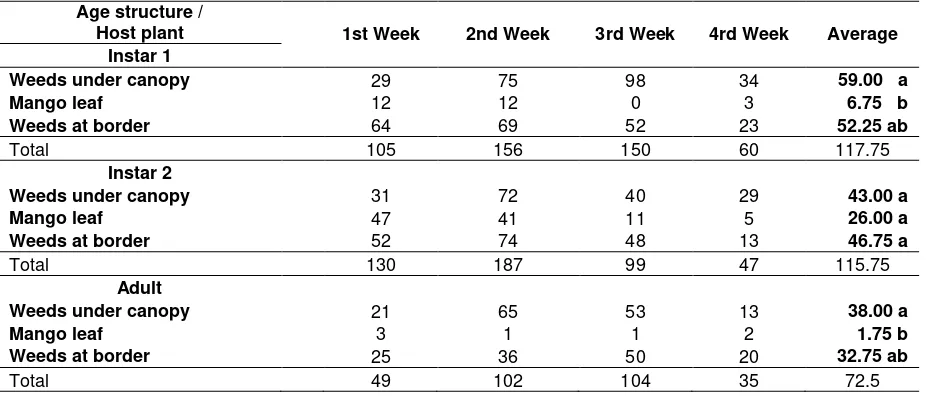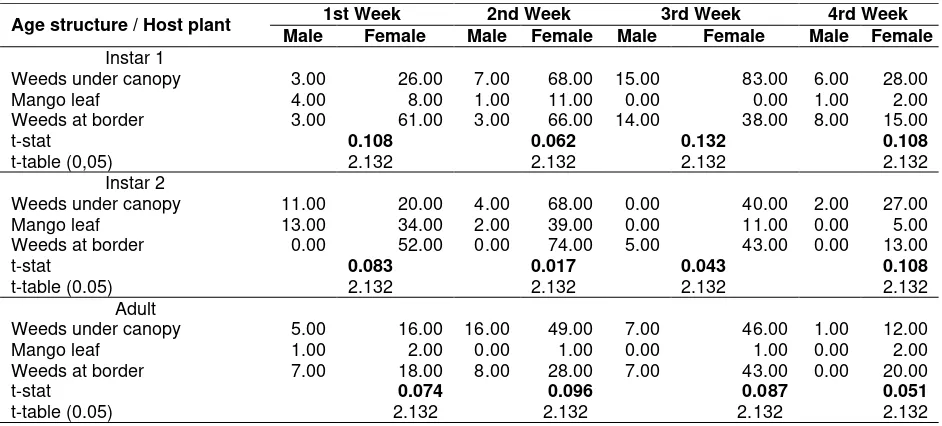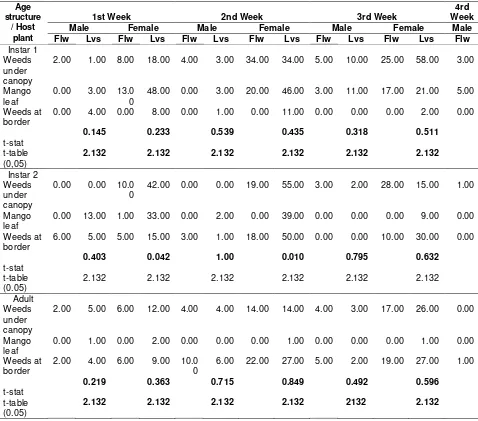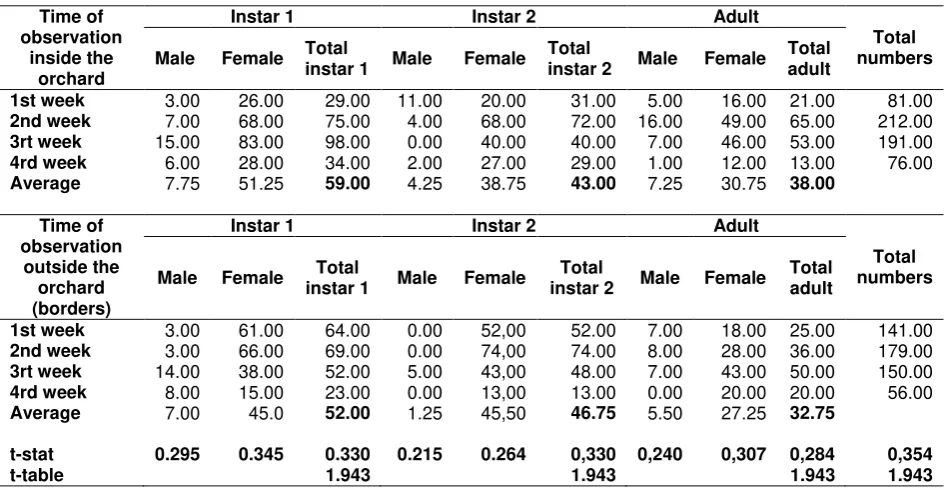AGE STRUCTURE AND SEX RATIO OF THRIP
Scirtothrips dorsalis
HOOD
(Thysanoptera : Thripidae) ASSOCIATING WITH MANGO AGROECOSYSTEM
IN EAST JAVA, INDONESIA
Affandi1*) and Celia dela Rosa Medina2) 1) Indonesian Tropical Fruits Research Institute
Jl. Raya Solok - Aripan KM. 8 Solok, West Sumatra, Indonesia, 27301 2) Department of Entomology, Crop Protection Cluster, College of Agriculture University of the Philippines, Los Baños, College, Laguna, Philippines, 4031
*) Corresponding author Phone: +62-20137E-mail: Affandi1970@yahoo.com
Received:July 2,013 /Accepted: September 12, 2013
ABSTRACT
The research conducted at PT. Trigatra Rajasa farm, Situbondo, East Java, Indonesia aimed to investigate the age structure and sex ratio of S. dorsalis Hood in mango agroecosystem. The research started from April to May 2013. A Com-pletely Randomized Design, Analysis of Variance and Least Significant Difference were used to design, knew the variance and significantly different among the treatment, respectively. Thirteen mango trees set in cross section were sampled and observed for the presence of S. dorsalis including weeds under the mango canopy and four cardinal directions of border. The sample was taken every week for one month. The result showed that instar one and adult were preferred to associate with weeds under the mango canopy and borders compared to mango leaves, except second instar. Further, observation was presented that all the age structures were given equal male female sex ratio. Based on the total number of population, there was no significant difference in age structure and sex ratio of S. dorsalis associating with weeds inside the orchard including mango leaves and borders. Twenty-seven species of weeds were discovered to associate with mango agroecosystem and were comprehensively discussed based on what was the most dominant and preferred by S. dorsalis. Keywords: S. dorsalis, age structure, sex ratio,
mango, weeds. INTRODUCTION
Mango is an exotic fruit originating from tropical Indo-Burma region. The demand of
mango fruit has increased recently, not only for tropical country but also for European and United Stated (Mukhejee and Litz, 2009). However, for export reason, high quality of fruit is inevitable necessity. High demand on mango, then, also requires high productivity of the mango tree.
Insect infestation is the most constrain for high production and quality target. Thrips are the pest known to cause agent for undeveloping flush, damaging flower, young fruit drop and scarring of immature and mature fruit in major mango production country such as India, Indonesia, Malaysia, Thailand, Philippines, South Africa, Mexico and Australia (Ananthakrishnan 1984, Morton 1987; Grove et al., 2000; Pena et al., 2002; Suputa et al., 2010; Aliakbarpour and Rawi, 2011a; Chin et al., 2010 and Rocha et al., 2012). In Indonesia, Malaysia and Philippines, species of Scirtothrips dorsalis (Hood) are the most abundance thrips associated with all stages of mango tree including weeds under the canopy (Affandi, 2012; Aliakbarpour and Rawi, 2011b; Muniappan, 2012).
Scirtothrips dorsalis which is attributed to have minute size, high reproductive potential and keen ability to adapt to new areas remains undetectable until its huge population exists. Hence, S. dorsalis is being major concern in agricultural sector in many countries for the last decade (Kumar et al., 2013). When its population is excessive, control action will not have any significant impact. Therefore, an initial early survey on the presence of S. dorsalis in mango and associate alternative hosts are obviously required. The age structure and sex ratio are essential components in assessing the population growth rate (Nunncy, 1983).
Accredited SK No.: 81/DIKTI/Kep/2011
A series of observation toward age structure and sex ratio could be used for population prediction. Moreover, it could be used as a prominent source of information whether controlling action needs to be done in relation to critical period of mango trees. The significance of sex ratio is associated with the mating habits of the species. Therefore, this research was to
The research was conducted from May to June 2013, during the last growth stage before the emergence of flower, in PT Trigatra Rajasa, Ketowan village, Arjasa subdistrict, Situbondo district, East Java Province, Indonesia.
Situbondo lies at a position between 7° 35' - 7° 44' SL and 113° 30' - 114° 42' EL. The site was located 30 m above sea level with average rainfall of 780 mm per year. The planting area normally had 3 wet months and 9 dry months yearly. These longer dry months with plenty of sunlight and short wet months made this area suitable for Arumanis 143 plantation.
Arumanis 143 was the only variety planted. The trees were planted monoculturally with distance of 8 X 10 m. The mango trees are 22 years old, yet they were 3-5 m high with parabolic canopy shape due to regular prunning. Application of good cultural practices such as regular prunning, weed control including pre and post harvest handling was given in order to produce high quality fruit.
The entire weed species associating with mango orchard and those at the border outside the mango orchard were sampled for the presence of S. dorsalis. Weed sample was taken under the canopy of mango trees (inside the orchard), in line cross transect, and so were the weeds outside the orchard (borders). The sample was segregated between the leaf and the flower. Three shoots per plant were sampled for monocotyledonous type of weeds and three apical leaves per branch for dicotyledonous type of weeds. Three flowers were also sampled in each weed. The sample was placed in the zip-lock plastic bag sized 25 x 15 cm. Hereafter, the plastic was brought to the laboratory for further treatment. Then, modification of Aliakbarpour and Rawi (2010) dipping method was
used to direct collection of the thrips associated with leaf and flower of weeds. The zip-lock plastic with each weed part, i.e. flower and leaf was half filled with ethanol 70% and agitated gently for 10 s. For better restore. The ethanol 70% with the thrips contain was transferred to the plastic jar. Furthermore, the ethanol was poured to the Petri disk and was directly observed using compound microscope for the presence of thrips. Sample of each weed was replicated 13 times. A series of weed sampling was done weekly for a month. The weeds associated with mango orchard were
The nuisance factors or variance among the treatments were eliminated by applying Completely Randomized Design. The variance among the data was analyzed by Analysis of Variance (Anova), and the significant difference among the treatment analyzed by Least Significant Different (LSD) test (p = 0.05). The data was also temperature, relative humidity, number of day, and volume of rainfall were also gathered from the orchard climatic station.
RESULTS AND DISCUSSION
Age Structure and Sex Ratio of S. dorsalis on Different Host Plant
(Seal et al., 2010). The pest prefers young plant tissue and it is not reported to feed on mature host tissues (Kumar et al., 2013), and most of the weeds associating with mango orchard are soft especially meristem tissue. Meanwhile, the mango
trees during observation were on the last dormant stage, hence, it was not associate with young plant tissue and tender plant part which were not preferred by S. dorsalis.
Adult stage of S. dorsalis associates with weeds instead of mango leaf. The presence of weeds with soft tissue and flower in all seasons will provide the pest with more nutrients. Pollen is a prominent source of protein for phytophagous thrips to produce eggs (Tsai et al., 1996). Adult females require source of protein to mature their ovaries and eggs. In part, protein deprivation may manifest itself in the failure to secrete juvenile hormone which is needed for ovary and egg development. Nation (2001) added that protein was a very important dietary for insects. Restriction of protein dietary less than 20 % resulted in low growth and high mortality of nymph. Thrips can consume pollen with a wide range of host plants, including the pollen of grass species that grow adjacent to mango trees (Chellemi et al. 1994). Adult thrips consume cell dilution of shoot leaf if the availability of pollen was limited (Teulon et al., 1993; Toapanta et al., 1996).
Scirtothrips dorsalis instar two prefers all available host plants such as weeds and mango leaves. It seems that this stage has no special nutrients requirement, for its development and adaptation capability are relatively high. Stadium of larvae prefers cell dilution of new growth and young plants, a very abundance source feed, and it is almost available all the times (Funderburk et al., 2002; Seal et al., 2006).
Based on t-test analysis, sex ratio observation on each age structure of S. dorsalis on weeds associating with mango orchard including mango leaves exhibited that all of the stages did not show significant difference on male female sex ratio. Similarly, sex ratio on each age structure on different host plant did not bear significant difference on weekly observation either (Table 2). Overall, there was also no preference among all age structures and sex differentiations towards host plant parts (flowers and leaves) (Table 3).
Table 1. Age structure of S. dorsalis in different host plant based on total population Age structure /
Host plant 1st Week 2nd Week 3rd Week 4rd Week Average Instar 1
Weeds under canopy 29 75 98 34 59.00 a
Mango leaf 12 12 0 3 6.75 b
Weeds at border 64 69 52 23 52.25 ab
Total 105 156 150 60 117.75
Instar 2
Weeds under canopy 31 72 40 29 43.00 a
Mango leaf 47 41 11 5 26.00 a
Weeds at border 52 74 48 13 46.75 a
Total 130 187 99 47 115.75
Adult
Weeds under canopy 21 65 53 13 38.00 a
Mango leaf 3 1 1 2 1.75 b
Weeds at border 25 36 50 20 32.75 ab
Total 49 102 104 35 72.5
Table 2. Sex ratio in each age structure, different host plant and observation time based on t-test analysis
Age structure / Host plant 1st Week 2nd Week 3rd Week 4rd Week Male Female Male Female Male Female Male Female Instar 1
Weeds under canopy 3.00 26.00 7.00 68.00 15.00 83.00 6.00 28.00 Mango leaf 4.00 8.00 1.00 11.00 0.00 0.00 1.00 2.00 Weeds at border 3.00 61.00 3.00 66.00 14.00 38.00 8.00 15.00
t-stat 0.108 0.062 0.132 0.108
t-table (0,05) 2.132 2.132 2.132 2.132
Instar 2
Weeds under canopy 11.00 20.00 4.00 68.00 0.00 40.00 2.00 27.00 Mango leaf 13.00 34.00 2.00 39.00 0.00 11.00 0.00 5.00 Weeds at border 0.00 52.00 0.00 74.00 5.00 43.00 0.00 13.00
t-stat 0.083 0.017 0.043 0.108
t-table (0.05) 2.132 2.132 2.132 2.132
Adult
Weeds under canopy 5.00 16.00 16.00 49.00 7.00 46.00 1.00 12.00
Mango leaf 1.00 2.00 0.00 1.00 0.00 1.00 0.00 2.00
Weeds at border 7.00 18.00 8.00 28.00 7.00 43.00 0.00 20.00
t-stat 0.074 0.096 0.087 0.051
t-table (0.05) 2.132 2.132 2.132 2.132
Sex ratio observation based on age structure, host plant and observation time revealed that there was no significant difference in population between male and female. In other words the sex ration could be simplified with 1:1 in number of population. Lewis (1973) stated that in equal number of sex ratio the females apparently predominate because they often live longer than the males. Sex ratio has important implication for population growth since the number of females at a given time has a significant effect on the composition of the next generation (Brown and Keller, 2000).
Host plant part preference (flower and leaves) of each age structure and kind of sex S. dorsalis indicated that both flowers and leaves were preferred by all age structures and sexes. It implies that S. dorsalis is capable of adapting to all growth stages and utilizing the available resources such as food, refuge and breeding habitat to prolong life sustainability. Kumar et al. (2013) reported that S. dorsalis is an opportunistic generalist species that is able to feed on a variety of host plants, depending upon present availability in the region. Its great reproductive potential and keen ability in invasion combined with easy adaptation to newly invaded areas are a few of the qualities
which make S. dorsalis a major concern for agriculture in many countries (Seal et al., 2010)
Age Structure and Sex Ratio of S. Dorsalis in Mango Orchard and Non Mango Agroe-cosystem
T-test analysis based on total population indicated that age structure and sex ratio of S. dorsalis associating with weeds inside the orchard and borders did not give significant difference (Table 4).
Table 3. Preference of each age structures and sex of S. dorsalis towards host plant parts (flowers and leaves) structures i.e. instar 1 and 2, including adult stage. Apparently, comprehensive and simultaneous biotic and abiotic factors such as the availability of food, breeding habitat and refuge including climate bolster for producing more offspring in balance sex ratio.
Similar research on Frankliniella occidentalis showed that winged species with a haplodiploid sex determination are assumed to disperse after emergence. Therefore, sex ratio is
close to 1 : 1. Further, S. dorsalis displays this type of behaviour dispersing immediately after hatching and adults move around frequently (Kumm, 2002).
Table 4. Comparison of age structure and sex ratio of S. dorsalis between inside and borders of mango orchard
Time of observation
inside the orchard
Instar 1 Instar 2 Adult
Total numbers Male Female Total
instar 1 Male Female
Total
instar 2 Male Female Total adult
1st week 3.00 26.00 29.00 11.00 20.00 31.00 5.00 16.00 21.00 81.00 2nd week 7.00 68.00 75.00 4.00 68.00 72.00 16.00 49.00 65.00 212.00 3rt week 15.00 83.00 98.00 0.00 40.00 40.00 7.00 46.00 53.00 191.00 4rd week 6.00 28.00 34.00 2.00 27.00 29.00 1.00 12.00 13.00 76.00 Average 7.75 51.25 59.00 4.25 38.75 43.00 7.25 30.75 38.00
Time of observation
outside the orchard (borders)
Instar 1 Instar 2 Adult
Total numbers Male Female Total
instar 1 Male Female
Total
instar 2 Male Female Total adult
1st week 3.00 61.00 64.00 0.00 52,00 52.00 7.00 18.00 25.00 141.00 2nd week 3.00 66.00 69.00 0.00 74,00 74.00 8.00 28.00 36.00 179.00 3rt week 14.00 38.00 52.00 5.00 43,00 48.00 7.00 43.00 50.00 150.00 4rd week 8.00 15.00 23.00 0.00 13,00 13.00 0.00 20.00 20.00 56.00 Average 7.00 45.0 52.00 1.25 45,50 46.75 5.50 27.25 32.75
t-stat 0.295 0.345 0.330 0.215 0.264 0,330 0,240 0,307 0,284 0,354
t-table 1.943 1.943 1.943 1.943
List of The Weeds Associating with Mango Orchard in The Study Area
Twenty seven weeds were found to associate with mango trees and border of site research site (Appendix 1). However, species of weeds such as Ischaemum rugosum Salisb, Desmanthus leptophyllus Kunth., Paspalum conjugatum P.J.Bergius, Tridax procumbens L., Passiflora foetida L., Ipomoea triloba L. and Acalypha indica L. dominantly associated with mango trees and border. The consecutive sequent of association was 17, 13, 10, 10, 9, 9 and 9, respectively. Meanwhile, other weeds were associate with mango trees and border in five or less.
The presence of S. dorsalis thrips associating with weeds must also be considered in term of population management, since some weeds shared little association but their weekly average total population was very high (Table 5).
Table 5. S. dorsalis the most prefered weeds that associate with mango orchard based on total population numbers
No. Weed 1st week 2nd week 3rd week 4rd week average
1 Ipomoea triloba L. 12 54 37 22 31.25 a
2 Desmanthus leptophyllus Kunth 17 45 41 16 29.75 ab
3 Tridax procumbens L. 7 41 37 5 22.50 ab
4 Arachis hypogaea L. 10 43 24 5 20.50 ab
5 Momordica sp. 6 10 41 21 19.50 ab
6 Digitaria ciliaris (Retz.) Koel. 18 19 26 10 18.25 ab
7 Tribulus terrestris(Caltrop.) 23 33 9 4 17.25 ab
8 Ischaemum rugosum Salisb. 12 24 16 11 15.75 ab
9 Mimosa invisa Mart. 3 15 22 9 12.25 ab
10 Passiflora foetida L. 14 21 9 2 11.50 b
Remarks: Means value in each column with the same letter is not significantly different (p = 0.05) based on Least Significantly Different (LSD) test
Terebrantia was influenced by the access of the larvae to nutrients. However, additional research was needed to determine suitability and preference of S. dorsalis toward certain weeds host associating with mango orchard.
CONCLUSION
Population number of each age structure was equal. Instar one and adult stage of S. dorsalis preferred associating with weeds in both under the mango canopy and at border, except for the second instar that spread prevalently on several plant leaves including mango leaves. Male and female sex ratio in all age structure and hosts associating with mango agroecosystem were equal. Twenty seven weeds were identified to associate with mango trees and borders. Species of weeds of Ischaemum rugosum Salisb was the most associated weed, while A. hypogaea L. was the most preferred weed by S. dorsalis.
ACKNOWLEDMENT
We deeply thank the Board of Directors, P.T. Trigatra Rajasa Farm for allowing us to use their mango orchards for research purpose. A special thanks are also extended to the field manager Ir. Mas Sudidjono and Administrative manager Arief Fadjar, AM.d for their assistance during the research.
REFERENCES
Affandi. 2012. Preliminary survey of thrips associate with mango in East Java,
mango central production of Indonesia. Special Problem Report. Department of Entomology, Crop Protection Cluster, University of the Philippines at Los Banos. Unpublished. 9 p.
Aliakbarpour, H. and C. S. M. Rawi. 2010. Diurnal activity of four species of Thrips (Thysanoptera: Thripidae) and efficiencies of three nondestructive sampling techniques for Thrips in mango inflorescences. Journal Economic Entomology, 103(3): 631-640.
Aliakbarpour, H. and C. S. M. Rawi. 2011a. The species composition of Thrips (Insecta: Thysanoptera) inhabiting mango orchards in pulau Pinang, Malaysia. Tropical Life Sciences Research, 23(1), 45–61.
Aliakbarpour, H. and C. S. M. Rawi. 2011b. Evaluation of yellow sticky traps for monitoring the population of thrips (Thysanoptera) in a mango orchard. Environmental Entomology, 40(4):873-879.
Ananthakrishnan, T.N. 1984. Bioecology of thrips. Michigan, USA: Indira Publishing House Oak Park. 233 p.
Brodbeck, B. V., J. Stavisky, J.E. Funderburk, P. C. Andersen and S. M. Olson. 2001. Flower nitrogen status and populations of Frankliniella occidentalis feeding on Lycopersicon esculentum. Entomologia Experimentalis et Applicata, 99(2): 165-172.
Chellemi, D.O., J.E. Funderburk and D.W. Hall. 1994. Seasonal abundance of flower inhabiting Frankliniella species (Thysanoptera : Thripidae) on wild plant host. Environmental Ecology, 23: 337-342. Chin, D., H. Brown, B. Conde, M. Neal, D. Hamilton, M. Hoult, C. Moore, B. Thistleton, L. Ulyatt and L. Zhang. 2010. Field Guide: Pest, Beneficial, Disease and Disorders of mangoes. NT Government, Dept. of Resources, Australia. 170 p. Cho, K., C.S. Eckel, J.F. Walgenbach and G.G.
Kennedy. 1995. Comparison of colored sticky traps for maonitoring Thrips populations (Thysanoptera : Thripidae) in staked tomato fields. Journal of Entomological Science, 30(2): 176-190. Chu, C., M.A. Ciomperlik., N. Chang., M.Richards
and T.J. Henneberry. 2006. Developing and Evaluating Traps for Monitoring Scirtothrips dorsalis (Thysanoptera: Thripidae). Florida Entomologist 89(1): 47-55.
Funderburk, J.E., J. Stavisky., C. Tipping., D. Gorbet., T. Momol and R. Berger. 2002. Infection of Frankliniella fusca (Thysanoptera : Thripidae) in peanut by the parasitic nematode Thripinema fuscu(Thylenchidae : Allantonematidae). Environmental Entomology, 31, 342-346. with mango trees in South Africa. African Entomology, 9(2): 153 -162.
Kumar, V., G. Kakkar, C.L. McKenzie, D.R. Seal and L.S. Osborne. 2013. An overview of chilli Thrips, Scirtothrips dorsalis (Thysanoptera : Thripidae) biology, distribution and management. In. Solenski, S and M. Larramendy (Eds.). Weeds and pest control – conventional and new challenges. Intech. Rijeka, Croatia. pp. 53-77
Kumm, F.S. 2002. Reproduction, progenesis, and embryogenesis of thrips (Thysanoptera, Insecta). Dessertation. Mathematisch-Naturwissenschaftlich-Technischen Fakultät. der Martin-Luther-Universität Halle-Wittenberg. 140 p.
Lewis, T. 1973. Thrips: their biology, ecology and economic important. Academic press London and New York. 348 p.
Moritz, G. 1997. Structure, growth and develop-ment. in. Lewis, T. (Ed.) Thrips as crop interaction. Annual Review of Entomology, 50: 247-269.
Moody, K., C.E. Monroe, R.T. Lubigan and C.E. Paller Jr. 1984. Major weeds of the Philippines, Weeds Science Society of the Philippines. University of the Philippines Los Baños, College, Laguna, Philippines. International, Massachusetts, USA. 168 p. Murai, T. 2000. Effect of temperature on development and reproduction of the onion thrips,Thrips tabaci Lindeman (Thysanoptera: Thripidae), on pollen and honey solution. Applied Entomology and Zoology, 35: 499–504.
Nation, J.L. 2001. Insect physiology and bioche-mistry.CRC Press, Florida, USA. 485 p. Nunncy, L. 1983. Sex differences in larval
competition in Drosophila melanogaster. The testing of a competition model and its relevance to frequency dependent selection. The American Naturalist, 121(1):67–93.
Pearsall, I. and Myers, J.H. 2000. Population dynamics of western flower thrips (thysanoptera: thripidae) in nectarine orchards in british columbia. J. of Economic Entomology, 93(2): 264-275. Peña, J.E., J. L. Sharp and M. Wysoki. 2002.
Tropical fruit pests and pollinators: biology, economic importance, natural enemies and control. CABI Publishing, Wellingford, UK. 443 p.
distribution of the western flower thrips (thysanoptera: thripidae), an early-season predator of spider mites infesting cotton. J.of Environmental Entomology, 17(3): 551-559.
Rocha, F.H., F. Infante., J. Quilantan., A. Goldarazena and J.E. Funderburk. 2012. ‘ata ulfo’ mango flowers contain a diversity of thrips (thysanoptera). Florida Entomologist, 95(1):171 -178.
Rumana, R and U. Sugandi. 1999. Weeds and control techniques on them (In Indonesian). Kanisius. Jakarta. Indonesia. 88 p.
Seal, D.R., W. Klassen and V. Kumar. 2010. Biological Pameter of Scirtothrips dorsalis (Thysanoptera : Thripidae) on Selected Host. Environmental Entomology, 39(5): 1389-1398.
Seal, D.R., M. Ciomperlik, M.L. Richards and W. Klassen. 2006. Comparative effectiveness of chemical pesticide again the chili thrips, Scirtothrips dorsalis Hood (Thysanoptera : Thripidae) on pepper and their compatibility with natural enemies. Crop Protection, 25: 949-955.
Suputa, Cahyaniati, A. Kustaryati, A. Hasyim, I.U. Hasanah, A. C. Ratnaningrum, M. Railan, S. Riyadi, B. Arga and Suryanti. 2010. Mango Pest Control and Recognition Guide (In Indonesian). Directorate of
Horticultural Plant Protection. Directorate General of Horticulture. 218 p.
Teulon, D.A.J., T.E. Kolb., E.A. Cameron., L.H. Mccornick and G.A. Hoover. 1993. Pear thrips, Taeniothrips inconsequens (Uzel) (Tysanoptera : Thripidae). New Zealand Entomologist, 20: 67-69.
Toapanta, M., J.E. Fanderburk., R.J. Beshear., S.M. Olson and T.P. Mack. 1996. Abundance of Frankliniella spp. (Tysanoptera : Thripidae) on winter and spring host plant. Environmental ecology, 25: 793-800.
Tsai, J.H., B.S. Yue., J.E. Funderburk and S.E. Webb. 1996. Effect of plant pollen on growth and reproduction of Frankliniella bispinosa. Acta Horticulture, 431: 535-541. Tsuchiya, M., S. Masui and N. Kuboyama. 1995.
Color Attraction of Yellow Tea Thrips (Scirtothrips dorsalis HOOD). Japan Journal of Applied Entomology and Zoology, 39: 299-303.
Vasiliu-oromulu, L. 2002. The dynamics of the sex ratio index of thrips populations in mountainous meadows. In. Marullo, R and L. A. Mound (Eds.) Conference Proceedings of Thrips and tospoviruses : proceedings of the 7th International Symposium on Thysanoptera. Calabria, Italy. pp. 315-324.
Appendix 1. Weeds found associate with mango trees and border of site location of the research and it dominance among others
No. Weeds Number of association with mango trees and borders
1 Ischaemum rugosum Salisb. 17
2 Desmanthus leptophyllus Kunth 13
3 Paspalum conjugatum P.J.Bergius 10
4 Tridax procumbens L. 10
5 Passiflora foetida L. 9
6 Ipomoea triloba L. 9
7 Acalypha indica L. 9
8 Pennisetum sp. 5
9 Unidentified 1. 4
10 Mimosa invisa Mart. 4
Appendix 1 ( Continued)
No. Weeds Number of association with mango trees
and borders
12 Momordica sp. 4
13 Lantana camara L. 3
14 Crotalaria retusa L. 3
15 Tribulus terrestris (Caltrop.) 3
16 Mimosa pudica L. 2
17 Arachis hypogaea L. 2
18 Achyranthes aspera L. 1
19 Crotalaria mucronata Desv. 1
20 Amaranthus spinosus L. 1
21 Cleome rutidosperma DC. 1
22 Capsicum annuum L. 1
23 Sida acuta Burm F. 1
24 Ipomoea carnea L. 1
25 Chromolaena odorata (L.) King & Robinson 1
26 Centrosema pubescens Benth. 1




